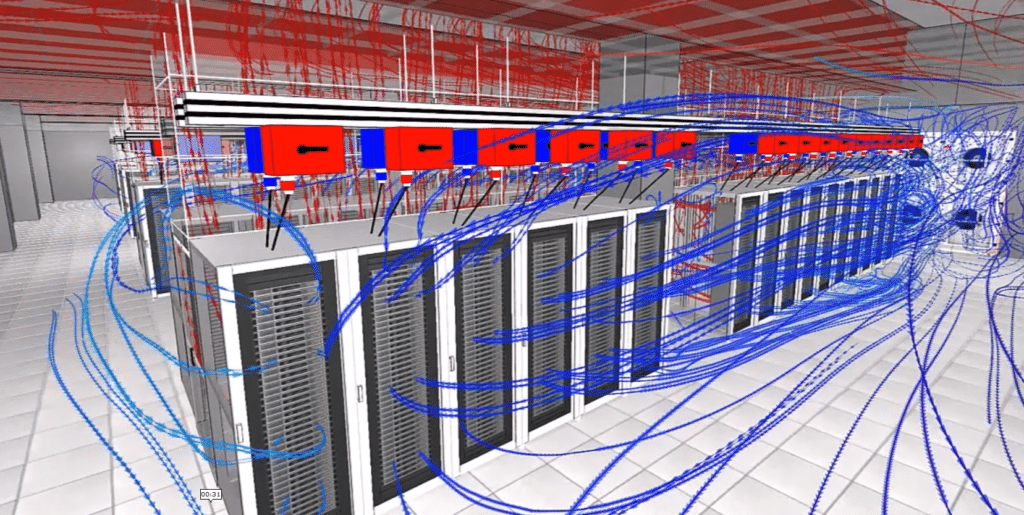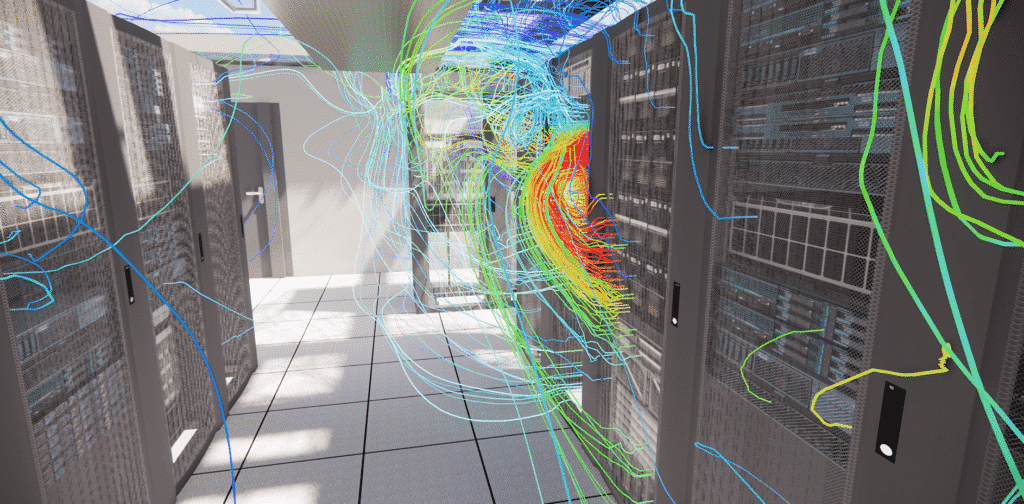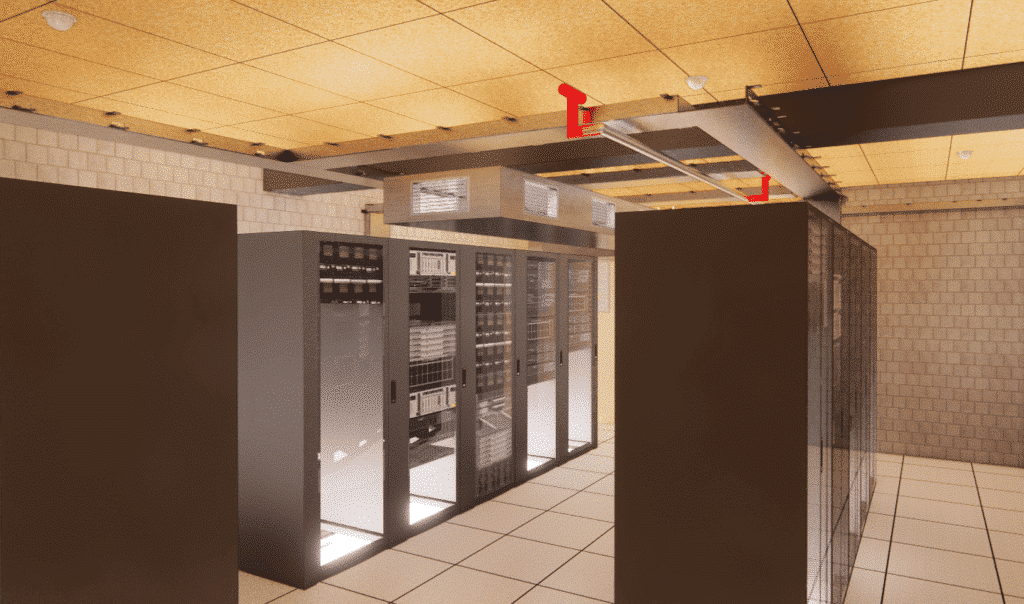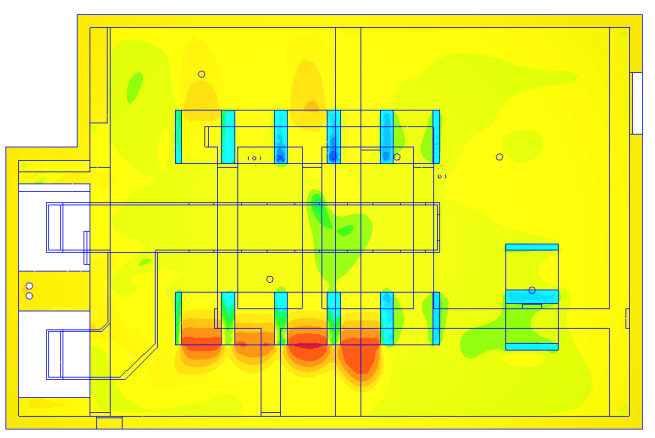Accueil » Data Center » Data Center Fire Simulation » Data Center – GAZ NOVEC
Data Center – GAZ NOVEC
Study of server input overheating risks
For an existing data center, after Audit, the objectives were to study the risks of overheating at the server entrance, to check the overall aeraulics of the room and then to model the dispersion of 3M™ NOVEC™ 1230 gas in case of fire.
Data Center - GAZ NOVEC
Year
2022
Customer
CHU PONTOISE
Location
France
Typology
Smoke control
Continue navigation :
- Data center audits and diagnostics
- CFD engineering for data centers
- Thermal study of technical premises
- Generators
- Designing your data center’s digital twin
- Urban heat island impact study for data centers
- External CFD simulation for data center
- Energy optimization and PUE calculation for data centers
- Data Center Fire Simulation
- Data center audits and diagnostics
- CFD engineering for data centers
- Thermal study of technical premises
- Generators
- Designing your data center’s digital twin
- Urban heat island impact study for data centers
- External CFD simulation for data center
- Energy optimization and PUE calculation for data centers
- Data Center Fire Simulation
Our other projects :
Latest news :
Technical files :
Main objectives of this mission
The main challenge in data center design is the perpetual continuity of the services it provides. Failures, maintenance and fires may occur, but the IT equipment must continue to function without being damaged. It is within this framework that EOLIOS provided its expertise in data center to make a study of climatic risk as well as a study of fire risk in the data hall of the SAMU 95.
The objectives were to visualize server inlet temperatures and verify overall room aeraulics and then model the dispersion of 3M™ Novec™ 1230 gas in the event of a fire.
Creation of a digital twin of the data center
For this study the entire data center was reproduced with 3D software. All the HVAC systems are taken into account in the modeling. The calculations also take into account the heat input through the walls of the data center.
The exact urbanization of the servers is implemented, it considers the throughput of each server as well as its power. The more accurate the digital twin created, the closer the results will be to reality. The mesh used contains about 10 million elements and is refined in the high gradient areas.
Main results obtained
In the context of the climatic risk study, the power balance of the rebreather does not reveal a power overload.
However, the lack of partitioning modules inside the racks at the empty server locations creates air recirculation.
These closures can be troublesome. Under standard conditions, the temperature increase is well controlled, the temperature is around 25°C at the server suction.
Despite the presence of bypass, the climatic conditions are respected. This indicates that the rebreathers are effective in terms of temperature control. In hot conditions, the recycler also manages to maintain an appropriate climatic environment for the computer equipment. The design is considered to meet expectations.
Study of fire risks in a Data Center
As part of the fire risk study, all gas characteristics are implemented in the simulation. It can be seen that the positioning of the 3 nozzles in the false floor allows to quickly prevent any risk in case of fire in this area, but also allows a diffusion through the floor at the data hall level. The same applies to nozzles in false ceilings. The simulation results show that the gas dispersion is as expected.
The fire diffusion system manages to disperse enough gas so that all the computer equipment as well as the risk areas have a concentration of gas greater than 5% in the surrounding air. For this configuration, the system is therefore in compliance with the recommendations.
The benefits of CFD simulation for data centers
Digital simulation offers new perspectives for design offices. This makes it possible to foresee a large number of scenarios and consequently to control all the unforeseen events linked to a bad design. In the case of climate risk management, multiphysics modeling allows to take into account the totality of the phenomena at the origin of the creation of loops or hot spots. In the case of fire risk management, CFD allows to represent the spatial and temporal evolution of the gas diffusion in view of these characteristics.
Moreover, the experience of EOLIOS in thermal and general aeraulics allows our team to propose innovative and relevant solutions in the case of climatic or fire risk. Nevertheless, implementing CFD simulations in your design process means calling on experts in fluid mechanics, thermal and numerical simulations.
Video summary of the study
Modeling of NOVEC gas dissipation in time, studies of fire fighting systems.
Continue on this topic
- Data center audits and diagnostics
- CFD engineering for data centers
- Thermal study of technical premises
- Generators
- Designing your data center’s digital twin
- Urban heat island impact study for data centers
- External CFD simulation for data center
- Energy optimization and PUE calculation for data centers
- Data Center Fire Simulation
- Data center audits and diagnostics
- CFD engineering for data centers
- Thermal study of technical premises
- Generators
- Designing your data center’s digital twin
- Urban heat island impact study for data centers
- External CFD simulation for data center
- Energy optimization and PUE calculation for data centers
- Data Center Fire Simulation
Discover other projects
External & internal CFD – Data Center Hyperscale
CFD Optimization – Data Center
Data Center – DC28 – Internal
Pressure loss study – Generator – Data center
Data Center – PA 22 – External
Technical premises – Data Center
Cooling optimization – Data Center
Data Centers – DC15.1 & DC15.2 – External
Data Center – Paris
Data Center – GAZ NOVEC
CFD-Data Center – Saint Denis
Data center – DC25 – Internal
Data center – DC17 – Internal
Data Center – DC10 – Internal
Data center – DC25 & DC26 – External
Data center – D14 – External
Data center – DC17 – External
DC23 – External








